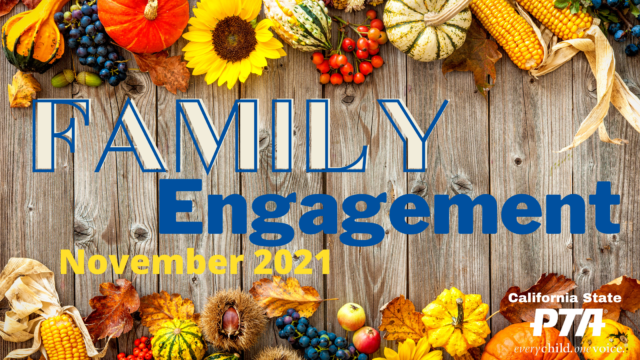
By Kathleen Fay, California State PTA Family Engagement Commission Consultant
As kids get older, family involvement in school and in PTA tends to drop off – even as stakes grow higher. When high school PTA leaders make family engagement a central goal, they can be instrumental in keeping parents/guardians/families engaged and active.
Your PTA gives families and community members a good reason to become engaged in the school community. By making your meetings matter – either virtually or in person, you provide your members with resources and shared power. Providing members with relevant and important information at your meetings, you can spark interest and attention and hopefully engage more families and community members.
Here are some meeting tips:
Make sure meetings are well-planned and well-run.
Apply this approach to your agenda to bring members to your meetings and keep them coming back:
- Plan. Promptly take care of association business at the start of the meeting; allow 20 minutes for this. (See leader tips on how to do this, below.)
- Present. Devote the bulk of your time to a presentation by school/community leaders, subject experts, or a panel of students who are invited to speak on a topic of interest and relevance to the lives of high school parents.
- Prevail. A good rule of thumb is to keep your meeting to no more than 75 minutes. Your local preferences will help determine a best time limit.
How can you ensure meeting business doesn’t go on too long?
PTA leaders make this possible by doing committee work in committee, so that precious meeting time is used to conduct the official business efficiently and effectively. High school PTA leaders need to plan carefully, prepare in advance, and make sure the business part of the agenda covers what needs to be done. Tips for making that happen include:
Invite speakers who can share important information.
When you are spending the bulk of your meeting time on presentations, vary the topics and presenters. Here are some presentation ideas (and possible speakers) to consider:
- What’s new this year at your high school – academics, programs, personnel, plans, facilities? (good opportunity for the principal to present)
- Tech Talk: (maybe a panel with a teacher, a district technology expert and a tech-savvy parent)
- Technology at school and what’s needed at home
- Online tools (specific to your school) and how to use them
- All About Teen Driving – parents are really interested in this! (invite someone from local law enforcement)
- Career Technical Education/Internships and Work-based Learning Programs: The hot new item on student resumés (ask a speaker from the Regional Occupational Program)
- Youth & the Law – Legal issues important to parents of minor children or new laws affecting teens that often take effect at the start of the year (reach out to a district spokesperson or the legislation chair from your District PTA)
- Student Panels: (have diverse students share their experiences and insights)
- What do you know …that we should, too? – Students share their experiences and insights about life on campus and off
- Activities and programs to increase student engagement – What have students themselves found most meaningful?
- Finding the Balance – Managing student priorities (good opportunity for counselors to present)
- College Eligibility and Admissions for Community College and UC/CSU, including testing and course-taking (ask counselors and/or local college admissions officials)
- Mental Health Matters – Issues teens face; resources & approaches (invite a local youth psychologist)
- Alcohol & Drug Prevention for students & families (use your local police or hospital to lead this)
- All About Testing – What tests are given when, what’s involved, why do they matter? (include teachers and/or counselors)
- College Preparation – It’s never too early (ask counselors or parents who have kids already in college)
- Meet your… [school board members]/[superintendents]/[administrators] (pick one or more)
- Building the School/District Budget – give parents the chance to express their priorities and understand decision making (allow extra time for this)
- Single Plan for Student Success – Inform parents about the school site budget process and recommendations going to the district (your school principal and members of the School Site Council)
- Local Control Accountability Plan (LCAP) – Conduct an LCAP input session with district leaders so they can hear what’s important to parents when constructing the district level LCAP
One advantage of this approach is greater cooperation – everyone works together so that your PTA gatherings offer real value for all involved.
- Students who participate in panels gain valuable experience preparing and presenting their insights about how activities and programs increase their engagement with school.
- Your greater school community contributes their expertise as guest speakers on a variety of topics important to parents of teens, and representatives from other organizations that support youth in the community attend and become engaged with your PTA. Remember to take advantage of your district’s own experts!
- Parents benefit from greater participation in PTA and become better educated about relevant issues. A better-informed parent is a better parent! And drawing the interest of school district leaders affords parents the opportunity to interact with these leaders directly at meetings (administrators, school board members, and superintendents).
Participation in PTA is vital to ensuring the kind of home-school connection that benefits the healthy development of youth. PTAs can positively impact the lives of members by providing programs of real value and relevance. As a PTA leader, you can help to build a connection to local school staff and administrators by enabling direct interactions, thus boosting family engagement. The information presented in these valuable programs can help to improve parenting skills and empower families and caretakers to take a more active role in their children’s education.

